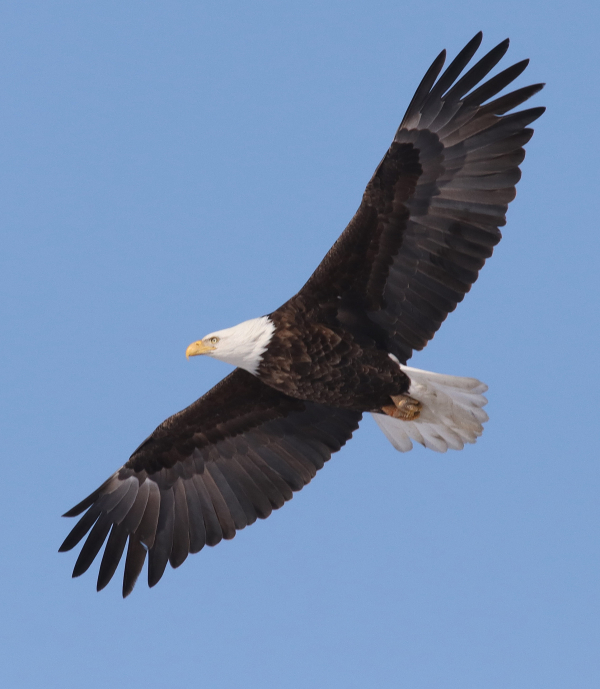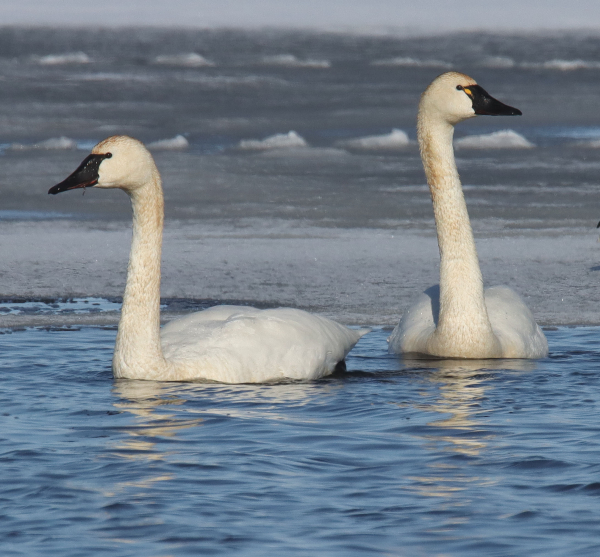
How lucky am I to live in the middle of a birding mecca 3 seasons of the year. Many of us probably feel the same way, but last Friday was an excellent day for photographing some remarkable birds close to home – really, just down the road from my office. At first I could see 2 Bald Eagles perched in a stand of trees, but as I approached more and more eagles materialized, and not only were there 7 Bald Eagles, including 4 adults and 3 immatures of varied ages, but 6 of the eagles were perched in the same tree! That was the most eagles I’ve seen together in the entire area to the south.
As I slowed to get into position for a photo, the eagles began taking flight one after another. I stopped and followed individuals through my camera lens as they circled back, with one even perching again. As each eagle flew closer – gliding, winging, banking this way and that – I focused on the closest one to take photos when appropriate, but I found myself ever changing my focus to the eagle that was flying closest – What Fun! How Exciting!

Banking into the wind, the subtle color variations of individual feathers were highlighted by bright sunlight, which also emphasized the breadth of its wings as they acted as ‘sails’ to propel the large, elegant eagle (600mm zoom lens, f-10 aperture, 1/1600 shutter speed, 400 ISO).
|
As one of the younger eagles flew to the east, a mega-flock of Snow Geese erupted into flight with a roar that only a thousand or more Snow Geese can make, and I photographed the Snow blizzard, wishing I could get the eagle in the frame filled with geese too. When I continued south, within the next 2 miles I sighted 4 more Bald Eagles (11 total), all within 4 miles of home!
Realistically though, this very local birding action started at Melody’s Marsh, just a half-mile south of home, where the ice just began melting back along the edges this week, but it already has become an exceptional location for bird photography. In fact, I checked back time and time again that afternoon to see how photo ops and bird positions changed, even as the quality of the sunlight became better and better through the late afternoon.
There were more than 200 White-fronted Geese, some lining the ‘iceberg’ centered in the open water, some swimming as they fed along the shore. There were Canada and Cackling Geese interspersed among them too – but even so, I knew I needed to check out the entire west side of the marsh before stopping to photograph. And sure enough, 2 ultra-big, ultra-white birds surrounded by brilliant blue water were the true stars of the show, and I eased my car into position with the sun at my back to photograph them as they were feeding close to a favorite pullout I use. It was impressive to see just how much bigger the swans were than the surrounding scattered Redheads, Mallards, and White-fronts; even the Giant Canada Geese were dwarfed by the pair of Tundra Swans.

The sun was still quite high, but the swans were close, and I appreciated the opportunity to photograph without disturbing them – they were aware of me, but not concerned. When I checked back a half-hour later they were lying on the ice with their head on their back resting. In the meantime I photographed White-fronted Geese in particular – swimming, bathing, resting, and as new flocks approached and landed. At a southern bay I photographed a few Cackling Geese and White-fronts resting along a grassy shore, then headed south again.
On the edge of the 4 mile mark, I encountered a huge concentration of waterfowl, anchored by several hundred Cackling Geese with White-fronted Geese, but also many flocks of Canvasbacks, mostly made up of males, along with many Redheads and Mallards too, and a lone male Hooded Merganser with its “hood” held erect – all as the 11th Bald Eagle soared above the far side of the lake. With birds like that between Mile 4 and home, there seemed to be no reason to venture farther that sunny afternoon. What I did do however, was to drive that 4 mile route a couple more times, which provided more photo opportunities at each of the bird-rich locations along the way.
Photo Tech

Although the ISO was originally set at 800, after taking a few photos of this pair of Tundra Swans, a quick check of the resulting images showed the white swans were being over-exposed at that setting; so the ISO was switched to 400 to compensate for the effect of the bright afternoon sunlight (600mm zoom lens, f-10 aperture, 1/2000 shutter speed, 400 ISO).
|
I started the afternoon with an 800 ISO setting, but during my initial photo episode with the Tundra Swans, with the sun high in the mid-afternoon sky I turned it down to 400 ISO because I sensed the white swans might be getting over-exposed. I checked that hunch by reviewing a few of the swan photos and that was indeed the case – the first photos I took were over-exposed. By using the 400 ISO setting instead, the exposure was normal with accurate colors. However, 3 hours later, as the sun was low and the light was dimming, I notched the ISO back up to 800, and that was the right move too as I photographed flock after flock of White-fronted and Cackling Geese leaving Melody’s Marsh to join a feeding flock in a nearby harvested cornfield.
Using the usual Aperture Priority (Av) camera setting, I wanted to use an aperture that would provide a little more area in focus than usual by using an f-10 aperture rather than my usual f-8, mostly because I was photographing flocks of birds ranging from 4 to 400 and more. But changing the aperture would affect the shutter speed, yet with ample bright sunlight, the resulting shutter speeds varied from 1/1600 to 1/2500 of a second, which in hindsight was plenty fast to stop the motion of flying eagles and geese.
Of course, I photographed with my attention to where the sun was in relation to the birds I wished to photograph at all times – keeping the sun at my back. Although I was covering a much smaller area than usual, just 4 miles along a north-south route, I still needed a vehicle to drive here and there and check back on the swans and eagles and other birds along that roadway. Most of the time I don’t get out of my vehicle because birds tend to over-react to the sight of people, and I often use my vehicle as a mobile blind with a lot of success. Birds are usually more trusting of a car that doesn’t approach too close; I motor slowly into position with my window open, even turning the engine off so I coast into place.
While that practice eliminates the sound of the motor, it also stops any vibration that’s caused by a running engine. As I focus on the birds, I hold my breath whenever I press the shutter button to take photograph, which by now is automatic (I don’t even think about it). I also brace my lens against the window frame of the car window to steady it, and double-check to make sure I’m holding my camera completely horizontal.
Any time I do step outside the vehicle, I help steady my camera by holding it with one hand while holding the lens in the other. Then I brace my elbows against my chest or the sides of my ribs, although when the action is fast with a bird flying quickly, I swing the camera freestyle to keep up with the bird’s flight. I still hold my breath when taking photographs while standing, and I’m aware of my movements and try to make them fluid, while not over-reacting.

Overall it’s exciting, it’s fun, it’s rewarding; sometimes it’s a little disappointing, which is part of the activity, and other times it’s fulfilling and the resulting images become an important part of my success as a photographer, as a birder, even as a biologist. Last Friday afternoon I was quite thrilled to find such exciting birds so close to home, and it was great fun to “limit” my usual roaming, searching, birding personality to a relatively small area. It made me appreciate what a wildlife rich location I’ve planted myself in during recent years. Each day I can go birding, near or far, and when the big urge arises, I live in the center of the continent where I can drive in any direction to visit other birding hotspots, near and far. I hope you enjoy plenty of quality birding opportunities, especially when photographing birds, in your own favorite ways, and I wish you Good Luck!
Article and photographs by Paul Konrad
Share your bird photos and birding experiences at editorstbw2@gmail.com